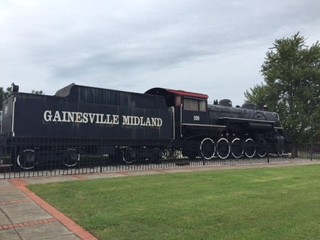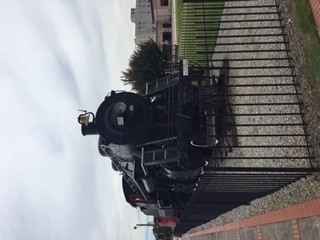Choo, choo... every little kid gets a kick out of trains. They're slow moving, the mechanisms that makes them go are pretty fascinating and they make some cool sounds. Since I indulge my inner child pretty frequently, my interest in the Gainesville Midland engine near the Gainesville Square was also indulged.
The Gainesville Midland's #209 Steam Locomotive, a decapod (meaning "ten wheels"), was actually built in America for the Czar of Russia, but when the Russian Revolution hindered that purchase in 1917, it stayed here in the states. The train has been in Gainesville's corner of the world since 1978 and it sits next to what used to be the train depot, which is now the Arts Center, with a coal car and a bright red caboose! It's also across the street from Poultry Park.
RailGa.com reports that the Gainesville, Jefferson and Southern Railroad used to go all around the region, including, obviously, Gainesville to Jefferson, but bankruptcy sent most the railway tracks into the arms of the newly formed Gainesville Midland in 1904. The Midland actually does still run from Athens to Gainesville, but it's operated by CSX. The Gainesville Midland still owns the tracks though.
Catiel Felts, spokeswoman for the City of Gainesville, wrote up a piece about the engine when it was renovated in 2004. She said the Gainesville Midland Railroad started in 1904 and ended the Atlantic Coast Line. The last steam run on the Midland was in September of 1959, from Athens to Gainesville, and it's believed that Engine 209 was one of the double headers.
For a little while the 209 Engine served as a railroad museum. It's been painted here and there, and there was that aforementioned renovation in 2004.
Felts said during that last renovation, crews updated the landscape around the train, removed asbestos, made new jackets for the boiler and cylinders, reinstalled some previously removed parts and repaired damages. The also cleaned out the fire box and the coal car for the first time since the train was decommissioned, Felts said, and professional painters replicated a design of the time with the train's title and number, bringing it back to life.
When I stop and look at the train, or drive by and just smile at it, I think, "This train looks pretty dang good for something that's outside all of the time." And it hit me the other day, "Hey, this train is outside all of the time, and it was last renovated in 2004. How do preservation teams keep it so nice?"
And then I remembered, my brother does that for a living. Brad has a degree in Historic Preservation from Savannah College of Art and Design and works at a train museum as a preservationist. So I asked him about it.
"There is a lot of work, time and money that goes into restoring a steam locomotive to operating condition," he said. "Pretty much everything has to be disassembled and gone over - flues all need to be replaced, the boiler has to be at least ultrasound tested, if not replaced, running gear needs to be remachined and tolerances checked- it's not something you can do in a weekend, and I haven't heard of a restoration costing less than a million dollars."
"A lot of times these locomotives that have been on display were run to death toward the end of their retirement, which is why a lot of them are so costly to restore. Suddenly, you're not just repairing all the weather damage from 40 years of being outside, but also years of maintenance deferment from when it was operating last. Fortunately, a cosmetic restoration is a lot more cost effective."
So what about the 209 - it's not an operational unit, so it falls in the "cosmetic" category - how does it face the elements?
"I haven't been able to view the 209 up close for several years now, but I do remember it being very well taken care of the last time I was there... keeping a locomotive out in the elements and having it look that good is pretty amazing. Usually they have issues with water - particularly rain settling in the boiler by way of an open smoke stack and that usually causes scale build-up in the boiler, as well as rusting the belly out underneath. I'm willing to bet the folks in charge of the upkeep have a 'cap' over the smoke stack to prevent that. "
But don't take my blog for it, or the thoughts of a professional. See it for yourself! I like to take West Academy and head towards Jesse Jewell, and park on the street somewhere before the IHOP. Poultry Park will be to your right that way, and then the train will be on the left, behind a fence. Check them both out!
Join me next week as I head to... well, somewhere else. I've got a whole list of places, but I'm open to suggestions. What are you wanting to know more about? Email me your ideas at [email protected]
Until then, stay curious.
This article merely touches on the details of the Gainesville Midland, which turned out to be surprisingly complex, but further research can be left up to you. The comments made in this feature article, by myself and by those who have been mentioned or quoted, do not necessarily reflect the opinions of Jacobs Media Corporation. Read, enjoy and explore at your own risk.












